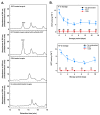Exogenous Ergothioneine and Glutathione Limit Postharvest Senescence of Arugula
- PMID: 39334799
- PMCID: PMC11429341
- DOI: 10.3390/antiox13091140
Exogenous Ergothioneine and Glutathione Limit Postharvest Senescence of Arugula
Abstract
Arugula is susceptible to postharvest deterioration. We tested the impact of exogenous antioxidant (i.e., ergothioneine and glutathione) dip solutions on arugula quality during storage at 4 °C or 10 °C for up to 17 days relative to a non-antioxidant treatment. Leaves from each dip treatment and storage temperature were assessed for visual quality and endogenous antioxidant metabolite profiles. Overall, leaf discolouration, wilting, and decay were more rapid at 10 °C than at 4 °C. Both antioxidant treatments limited leaf discolouration at 4 °C. Exogenous ergothioneine reduced wilting at 4 °C, whereas exogenous glutathione limited the incidence of leaf decay. At 10 °C, glutathione reduced the incidence of discolouration and decay, whereas both antioxidant dip treatments limited the decline in leaf yellowing. Ergothioneine was solely detected in ergothioneine-treated leaves; a decrease occurred within the first two days of storage but was unchanged thereafter. Although both antioxidant treatments did not affect endogenous glutathione concentrations at either storage temperature, glutathione disulfide was stable within the glutathione-treated leaves, whereas it increased in the other treatments. Ascorbate degradation was delayed in ergothioneine-treated leaves at 4 °C relative to all other treatments, whereas both antioxidant treatments little affected ascorbate metabolism in leaves stored at 10 °C.
Keywords: arugula; ascorbate; ergothioneine; glutathione; postharvest; senescence.
Conflict of interest statement
The funders had no role in the design of the study; in the collection, analyses, or interpretation of data; in the writing of the manuscript; or in the decision to publish the results.
Figures







Similar articles
-
Exogenous melatonin delays postharvest fruit senescence and maintains the quality of sweet cherries.Food Chem. 2019 Dec 15;301:125311. doi: 10.1016/j.foodchem.2019.125311. Epub 2019 Aug 1. Food Chem. 2019. PMID: 31398670
-
The effect of exogenous 24-epibrassinolide pretreatment on the quality, antioxidant capacity, and postharvest life of wucai (Brassica campestris L.).Food Sci Nutr. 2021 Jan 23;9(3):1323-1335. doi: 10.1002/fsn3.2075. eCollection 2021 Mar. Food Sci Nutr. 2021. PMID: 33747448 Free PMC article.
-
Exogenous glutathione maintains the postharvest quality of mango fruit by modulating the ascorbate-glutathione cycle.PeerJ. 2023 Aug 22;11:e15902. doi: 10.7717/peerj.15902. eCollection 2023. PeerJ. 2023. PMID: 37637166 Free PMC article.
-
Selenium vitaminology: The connection between selenium, vitamin C, vitamin E, and ergothioneine.Curr Opin Chem Biol. 2023 Aug;75:102328. doi: 10.1016/j.cbpa.2023.102328. Epub 2023 May 24. Curr Opin Chem Biol. 2023. PMID: 37236134 Free PMC article. Review.
-
Safe and Effective Antioxidant: The Biological Mechanism and Potential Pathways of Ergothioneine in the Skin.Molecules. 2023 Feb 8;28(4):1648. doi: 10.3390/molecules28041648. Molecules. 2023. PMID: 36838636 Free PMC article. Review.
Cited by
-
Biosynthesis of ergothioneine: current state, achievements, and perspectives.Appl Microbiol Biotechnol. 2025 Apr 12;109(1):93. doi: 10.1007/s00253-025-13476-4. Appl Microbiol Biotechnol. 2025. PMID: 40220171 Free PMC article. Review.
References
-
- Di Gioia F., Renna M., Santamaria P. Sprouts, microgreens and “baby leaf” vegetables. In: Yildiz F., Wiley R., editors. Minimally Processed Refrigerated Fruits and Vegetables. Springer; Boston, MA, USA: 2017. pp. 403–432. (Food Engineering Series). - DOI
-
- Wright K.P. Salad greens. In: Gross K.C., Wang C.Y., Saltveit M., editors. The Commercial Storage of Fruits, Vegetables, and Florist and Nursery Stocks. U.S. Department of Agriculture, Agricultural Research Service; Washington, DC, USA: 2016. pp. 538–540. Agriculture Handbook 66.
-
- Clarkson G.J.J., Rothwell S.D., Taylor G. End of day harvest extends shelf life. HortScience. 2005;40:1431–1435. doi: 10.21273/HORTSCI.40.5.1431. - DOI
Grants and funding
LinkOut - more resources
Full Text Sources

